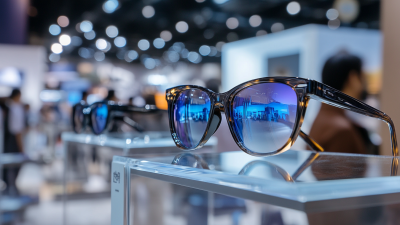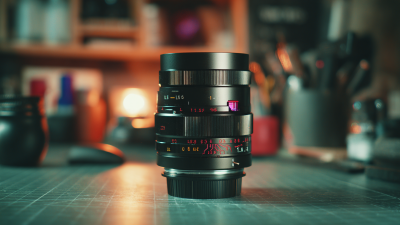In recent years, the optical industry has witnessed significant advancements in lens technology, particularly with the rise in popularity of resin lenses. According to a report from the Vision Council, the use of resin lenses in eyewear has surged by over 35% in the last five years, reflecting their superior lightweight properties and shatter-resistant features compared to traditional glass lenses. As more consumers seek comfortable and durable eyewear options, understanding the nuances of resin lenses becomes crucial.

This guide aims to demystify resin lenses, providing comprehensive information on their composition, benefits, and the criteria for choosing the right pair for your specific needs. Whether you are a seasoned eyewear enthusiast or a first-time buyer, this definitive resource will equip you with the knowledge necessary to make informed decisions in your quest for optimal vision.
When it comes to eyewear, understanding the materials used in lenses is crucial for making informed choices.
Resin lenses, known for their lightweight characteristics and impact resistance, are a popular option among consumers. These lenses are made from a type of plastic, specifically CR-39, which was developed in the 1940s. The properties of resin lenses provide excellent optical clarity, making them a preferred choice for everyday use in prescription and non-prescription eyewear alike.
In addition to their weight and resilience, resin lenses also offer a variety of options in terms of coatings and treatments. Users can select from anti-reflective coatings, scratch-resistant finishes, and UV protection, enhancing their performance and longevity. Furthermore, resin lenses can be easily tinted or polarized, allowing wearers to customize their eyewear based on their needs and lifestyle. Understanding these features not only helps in selecting the right pair of glasses but also enhances overall comfort and protection for your eyes.
Resin lenses have increasingly become a popular choice across various industries due to their remarkable properties and versatility. This comprehensive breakdown explores the different types of resin lenses available in the market, emphasizing their unique attributes. Polycarbonate lenses are known for their high impact resistance, making them ideal for sports eyewear and children's glasses. On the other hand, CR-39 (Columbia Resin 39) lenses are lightweight and offer excellent optical clarity, making them a favored option for everyday eyewear.
Recent advancements in 3D printing technology have further expanded the potential applications of resin lenses. The integration of low-cost resin printers to produce mesoscale optical components allows for greater design flexibility and reduced material wastage. According to industry data, the global market for 3D printed optical components is forecasted to grow substantially, driven by increased demand in sectors such as aerospace, automotive, and medical industries. This growth highlights the adaptability of resin materials and their potential in creating customized optical solutions, paving the way for innovations that were previously unattainable with traditional manufacturing methods.
When it comes to eyewear, making the right choice can significantly impact visual clarity and comfort. Resin lenses stand out as a superior alternative to traditional glass or polycarbonate options. One of the primary benefits of resin lenses is their lightweight nature, which enhances comfort for everyday wear. Unlike glass, which can be cumbersome and heavy, resin lenses allow for longer periods of use without discomfort. This is particularly important for individuals who require prescription lenses and wear them throughout the day.

In addition to their lightweight properties, resin lenses also offer superior shatter resistance. This makes them an ideal choice for active individuals or those in environments where lens durability is crucial. Glass lenses tend to break easily, posing a safety risk. Moreover, resin lenses provide excellent optical clarity and can be customized with various coatings to enhance their performance. From scratch resistance to anti-reflective coatings, these enhancements further make resin lenses a practical and appealing option for those seeking both protection and clarity in their eyewear.
Proper care and maintenance of resin lenses are vital to ensuring their longevity and optimal performance. Unlike traditional glass lenses, resin lenses are lighter and more impact-resistant, but they can also be susceptible to scratches and abrasions if not handled correctly. To maintain their clarity, it's essential to clean them with a microfiber cloth and a gentle lens cleaner specifically designed for eyewear. Avoid using paper towels or clothing that may harbor debris, as these can create small scratches on the surface.
In addition to regular cleaning, storage plays a crucial role in maintaining the condition of your resin lenses. Always store your eyewear in a protective case when not in use, and keep them away from extreme temperatures or direct sunlight, which can warp the frames or affect the lens material. If you notice any signs of wear, such as scratches or discoloration, consider taking them to a professional for polishing or replacement to ensure you continue to enjoy clear and comfortable vision.
| Aspect | Details |
|---|---|
| Material | Resin |
| Weight | Lightweight, offers comfort for long wear |
| Durability | Resistant to scratching but can be damaged by impact |
| UV Protection | Some resin lenses come with UV protectants |
| Care Tips | Use a microfiber cloth and lens cleaner for maintenance |
| Cleaning Solutions | Avoid ammonia-based cleaners; opt for gentle solutions |
| Storage | Keep lenses in a protective case when not in use |
| Scratch Resistance | Look for coatings that enhance scratch resistance |
| Cost | Generally more affordable than glass lenses |
| Customizability | Available in various tints and prescriptions |
When it comes to selecting the right resin lenses, understanding your specific needs is crucial. Resin lenses are lighter and more impact-resistant than traditional glass lenses, making them a popular choice for eyewear. However, their performance can vary dramatically based on factors like prescription requirements, lifestyle, and budget. To ensure you make the best decision, take the time to assess your daily activities and how your lenses will support your vision.
One important tip is to consider the lens index, which refers to the lens thickness and weight. Higher index lenses can provide thinner profiles without sacrificing optical quality, ideal for those with stronger prescriptions. Additionally, think about the lens coatings available, such as anti-reflective and scratch-resistant options. These coatings can enhance durability and improve visual clarity, making your experience more enjoyable.
Finally, don’t overlook the importance of UV protection. Resin lenses can effectively block harmful UV rays, which is essential for maintaining eye health, especially if you're often outdoors. By taking these considerations into account, you'll be better equipped to choose the resin lenses that best fit your lifestyle and visual needs.








